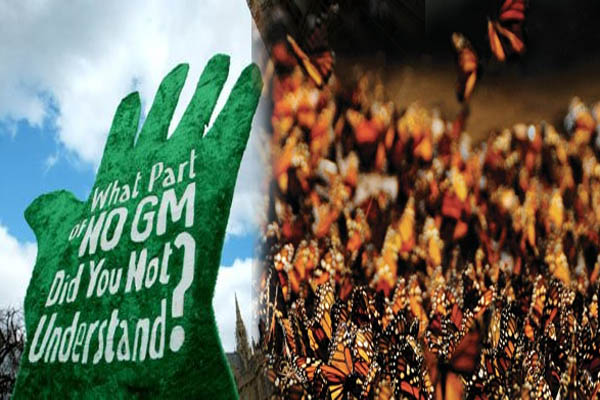Alex Pietrowski
Waking Times
The monarch butterfly is yet another animal species that appears to be in rapid decline due to the rise in herbicide-resistant genetically modified (GM) crops. These butterflies lay eggs on milkweed plants, and once the eggs hatch, monarch caterpillars feed exclusively on the weed. Yet, the overuse of Monsanto’s Roundup herbicide across millions of acres of Roundup Ready crops is believed to be destroying the milkweed necessary for monarch butterflies to thrive.

Cornell University was the first to raise attention to the harm that GM crops may have on these vivacious creatures, claiming that toxic pollen from GM corn would drift onto milkweed, poisoning monarch caterpillars and butterflies. Cornell’s research was criticized, and the United States National Academy of Sciences claimed that GM corn posed no risk to populations of monarch butterflies, as the amount of pollen that travels from GM corn onto milkweed was not sufficient to harm the caterpillars.
Yet, the species has been declining steadily since 1999. Why?
Now, researchers at University of Minnesota and Iowa State University once again reveal studies with the same conclusion: monarch butterfly populations are declining due to the proliferation of GM crops. Although the conclusion is the same, the underlying reason is different. The heavy use of herbicides on herbicide-resistant crops is changing the ecological landscape of farm lands. The milkweed plant is beginning to disappear, and with it, so is the monarch butterfly.
“The researchers estimate that the amount of milkweed in in the Midwest plunged by 58 percent from 1999 to 2010, pressured mainly by the expansion of Roundup Ready genetically engineered crops. Over the same period, monarch egg production in the regions sank by 81 percent.” Source: Mother Jones
“Another study published in the journal Crop Protection and conducted by Robert G Hartzler, an agronomist at Iowa State, found that milkweed on farms in Iowa declined 90 percent from 1999 to 2009. Additionally, his study found milkweed only on 8 percent of corn and soybean fields surveyed in 2009, which is 51 percent lower than in 1999.” Source: Global Research
What are we willing to sacrifice for GM crops?
Worldwide, pollinator bees are disappearing, and researchers are now blaming the global overuse of pesticides in colony collapse disorder. Now we are looking at exterminating the iconic and beautiful Monarch.
Perhaps to some, the decline and potential future loss of an animal species is insignificant, and some might argue that trying to solve the problem of world hunger certainly comes with costs. Yet, the issue here is much bigger. We are discovering new fortuitous consequences that come with the use of GM crops. Although most may be unintentional, these consequences are destroying the biodiversity of our planet, and other potential solutions to world hunger and food shortages are being overlooked and even derailed in the rush to create boutique crops dependent on chemical companies.
The final question then arises. At which point will the human species start to feel a more direct impact that genetic modification of crops on our habitats, our ability to grow nutritious foods, and our ability to nurture our bodies?


Thinks of the billions, possibly trillions, of dollars the US govn’t would save it it stopped funding or giving Grants or Incentives or tax breaks to Monsanto (Cheney buds) or GMO research. Grrrrrrrrrrr.
A 12 year old farm kid riding his bicycle along farm roads could shoot videos like these showing Monarch butterflies are still abundant on the GMO crop farmlands
of the upper Midwest:
http://www.youtube.com/watch?v=0jhKBj3rRt0
http://www.youtube.com/watch?v=vpEyRuh4lwg
http://www.youtube.com/watch?v=iatYTlT1qYQ
The same12 year old could also shoot a video showing bumblebees, honeybees
are abundant too:
http://www.youtube.com/watch?v=jZCOJnJU1UE
A farm kid could even go to USDA website that shows the supply of honeybee colonies in the USA has been steady (not declining) the past 12 years:
http://community.lsoft.com/scripts/wa-LSOFTDONATIONS.exe?A2=ind1204&L=BEE-L&O=A&P=227429